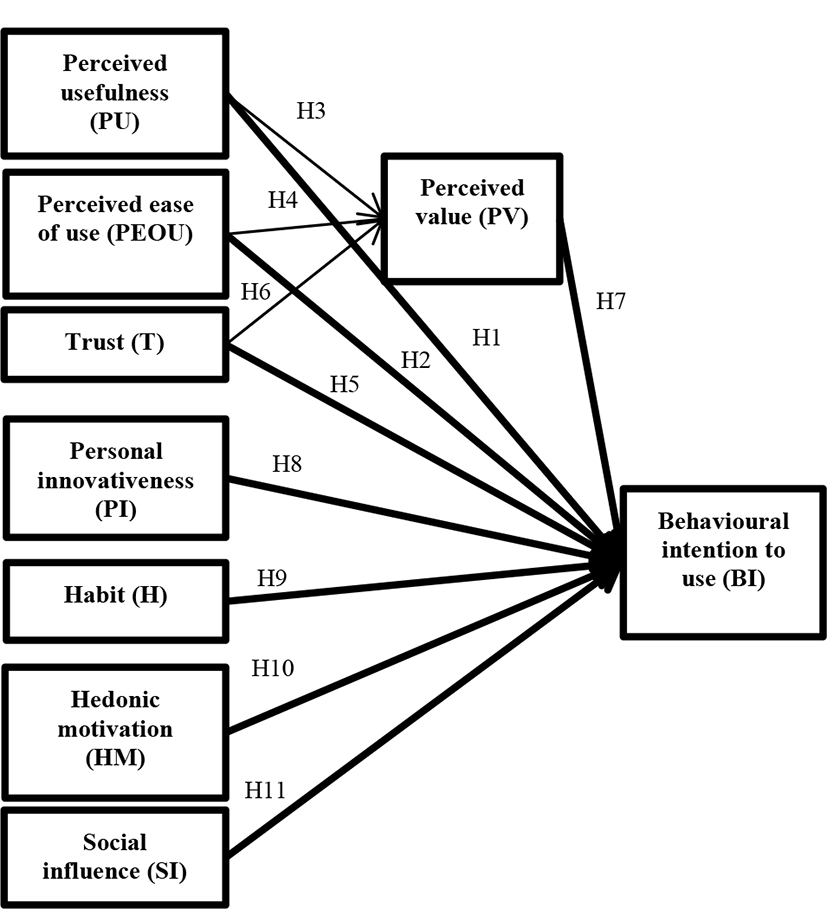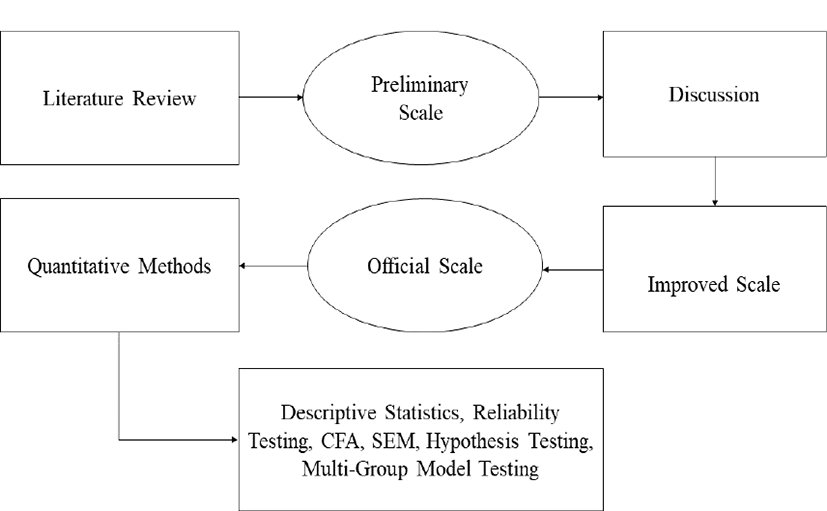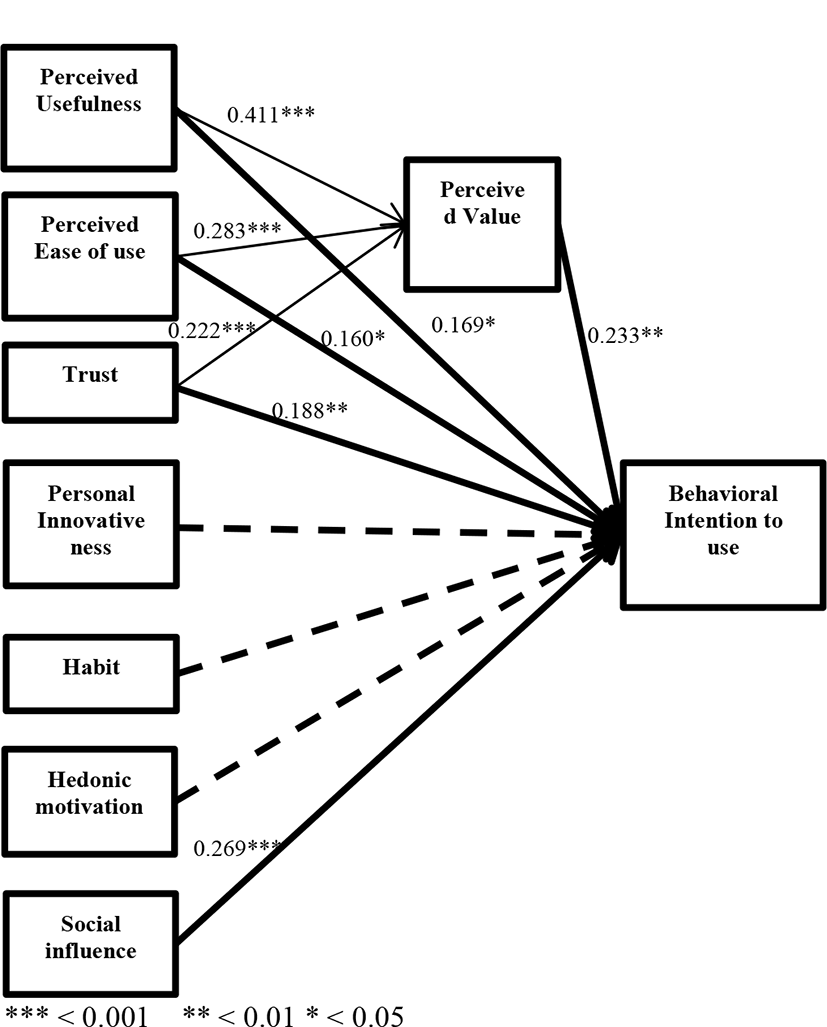I. INTRODUCTION
Today, people are used to living with the 4.0 technology trend. For this revolution 4.0, Smarthome is one of the most popular topics. In Vietnam, SmartHome has emerged since 2007 with the popular name such as BKAV, followed by Lumi, Acis, etc. They give customers more choices. However, the revenue for this field is not growing strongly, there is no good breakthrough. So what are they influence their decision to use Smarthome when they have sufficient finance and social capacity? What are the main factors influencing their intention to use Smarthome appliances? In response to these inquiries, we have researched to provide good results and applications for the Smarthome appliance vendors.
A study of factors affecting the intention to use smart housing in Thailand: A Pilot Study by Atchara Leeraphong, Borworn Papasratorn and Vithida Chongsuphajaisiddhi. The article discusses the use of smarthome in the Asia-Pacific region, ASEAN, in particular: In Europe and North America, the use of Smarthome appliances and systems are becoming increasingly popular. Estimated revenue for the region by 2020 is $ 36.21 billion, this proves strong growth and adoption of Smarthome is very high. By contrast, the estimated revenue for the Asia-Pacific region is $ 9.23 billion. By a simple calculation, we find that the difference in revenue is too large between the two regions. This indicates that the Asia-Pacific region has not used Smarthome as much as in Europe and North America. These figures show that modern smarthome are increasingly focused and consumed.
Vietnam is a country in the Asia-Pacific region. In Vietnam, Smart Home has appeared since 2007, with BKAV company – the market leader. BKAV is known as a trading company for computer software and expanded to sale Smart home appliances. At that time, the country’s economy was underdeveloped; people had low incomes and the amount of information on smart devices they received was inadequate. Therefore, Vietnamese are by no means interested in using Smart home. But the country’s economy has developed in the past 11 years. Vietnam has emerged from a poor country and now they have become a middle-income country. People here have better financial conditions as well as more information about Smart Home.
At the same time, a number of Smart home businesses were launched, such as: Lumi (Launch of touch switches and smart home solutions in early 2012), ACIS (known as from the research of Alumni – Bach Khoa university),… This help customers have more choices. In addition, many Smart City projects have been launched nationwide. However, the revenue for this field is not strongly grown and there is not good breakthrough. So what influences do people’s decision impact on using Smart Home when they have enough conditions for finance and society? What are the main factors influencing the adoption of their Smart Home appliances? In response to these questions, we have researched to produce positive results and applications for Smart Home manufacturers and providers, helping them improve their marketing.
This research will be meaningful in two respects, namely: theoretically, the research aims to find out what factors influence the intention to use Smarthome devices and test those factors in the market in Vietnam. In practicing, the research results will provide useful information to Smarthome suppliers so that they can create the right products in the Vietnamese market to meet their needs bridge users and are the premise for future research.
So, in the next sections of this paper, literature review will be introduced, next research methodology and findings are introduced. Finally, conclusions, limitations and future work are produced.
II. LITERATURE REVIEW
In 1975, Theory of Reasoned Action was established to predict and explain human beings’consciously intended behavior in social psychological field and was used for studies regarding consumers’ adoption to innovate technology theory by Ajzen and Fishbein. TRA stated that individual behavior is determined by behavioral intention to perform the behavior, whereas the intention is jointly determined by attitude toward behavior and subjective norm concerning the behavior (Ajzen and Fishbein, 1980). The attitude toward behavior is an individual’s evaluated affect about performing the behavior and the subjective norm is a person’s perception that most people who are important to him think he should or should not perform the behavior.
Theory of Planned Behavior of Icek Ajzen (1988, 1991) stated that human behavior is guided by three kinds of considerations: beliefs about the likely outcomes of the behavior and the evaluations of these outcomes (behavioral beliefs), beliefs about the normative expectations of others and motivation to comply with these expectations (normative beliefs), and beliefs about the presence of factors that may facilitate or impede performance of the behavior and the perceived power of these factors (control beliefs). Behavioral beliefs produce a favorable or unfavorable attitude toward the behavior; normative beliefs result in perceived social pressure or subjective norm; and control beliefs give rise to perceived behavioral control. Attitude toward the behavior, subjective norm, and perception of behavioral control lead to the formation of a behavioral intention.
Technology Acceptance Model (TAM) which introduced by Davis (1989), was a revision of TRA, to predict and explain a person’s adoption of information technology. TAM identifies two factors, perceived ease of use and perceived usefulness. Perceived ease of use is defined as the extension of an individual believes that using the system will be free for effort, perceived usefulness is defined as the extension of an individual believes that using the system will enhance the job performance. According to TAM, the usage of information technology is influenced by intention to use the information technology, while behavioral intention is jointly determined by perceived usefulness and attitude toward information technology usage. And perceived usefulness is influenced by perceived ease of use and external variables. Several studies and researches proved the efficiency and the legitimacy of the TAM, supported the theory of TAM and expanded the applicability of the TAM (Lee at al., 2011; Lin et al., 2011; Shin, 2007; Chau, 2011;).
The extended TAM model (TAM2), is also defined as an individual’s intention to use, which is jointly determined by two factors, perceived usefulness and perceived ease of use. However, TAM2 added two theoretical constructs: cognitive instrumental processes and social influence processes. Four cognitive factors influence perceived usefulness: job relevance, output quality, result demonstrability, and perceived ease of use. Three social forces influence perceived usefulness: subjective norm, image, and voluntariness. Job relevance is an individual’s perception of the degree to which the technology is applicable to his or her job. Output quality is an individual’s perception of how well a system performs tasks necessary to his or her job. Result demonstrability is the tangibility of the results of using the technology. Perceived ease of use impacts on perceived usefulness both directly and indirectly. Subjective norm is defined as a person’s perception that people think that she should or should not use the technology. Image is the degree which perceives the use of the technology as a means of enhancing one’s status within a social group. Finally, voluntariness is the extention which perceives the adoption decision as non-mandatory.
Unified Theory of Acceptance and Use of Technology (UTAUT) is an improvement in TAM2 developed by Venkatesh and colleagues to describe technology acceptance behavior in a organization, whereas extension of UTAUT (UTAUT2) was a revision of UTAUT, which focused on individual opinion. Therefore, consumers can adapt to the acceptance and usage of specific market, the UTAUT2 stated that the information technology’s intention to use was influenced by seven factors (performance expectancy, effort expectancy, social influence, facilitating conditions, hedonic motivation, price value, habit), four of which was inherited from UTAUT model and three new factors (hedonic motivation, price value, habit) and constructed the new relationships (Venkatesh et al., 2012). Hedonic motivation is a interest and satisfaction from using technology; price value is a consumer’s overall assessment of the utility of a product (or service) basing on perceptions of what is received and what is given; habit is defined as the extention to people who tend to perform behaviors (use IS) automatically because of learning. In addition, this new model was a revision from: the revisions of the TAM model, the UTAUT model by Venkatesh et al. (2003); TAM 2 (van der Heijden, 2004); habit model (Limayem, Hirt, & Cheung, 2007); the use of technology (Burton-Jones & Straub, 2006); the continuance of ICT usage (Bhattacherjee, 2001; Hong, Thong, & Tam, 2006; Thong, Hong, & Tam, 2006).
Extended theory of acceptance and use of technology (UTAUT2) was presented by Venkatesh et al. (2012) with an aim to explore factors affecting acceptance and use of technology with consumers’ perspective. According to Venkatesh et al. (2012) this new extended theory of acceptance and use of technology (UTAUT2) extends older version of Venkatesh et al.’s (2003) theory of acceptance and use of technology (UTAUT) by integrating three new constructs i.e. (1) Hedonic Motivation, (2) Price Value and (3) Habit; along with four main constructs i.e. (1) Performance Expectancy (PE); (2) Effort Expectancy (EE); (3) Facilitating Conditions (FC) and (4) Social Influence (SI) as determinants of Use Behaviour and acceptance of technology in consumers.
Personal innovativeness (PI) in the domain of information technology (IT) has an undeniable relation with technology adoption. Various scholars (e.g. Agarwal and Prasad, 1998; Dutta et al., 2015; Farooq, 2016; Karahanna et al., 2002; Rosen, 2004) have suggested that personality traits, such as personal innovativeness (PI) play an important role for technology adoption in the domain of IT. This study is an effort to empirically explore the role of personal innovativeness (PI) for determining acceptance and use of Smarthome. According to Schillewaert et al. (2005) personal innovativeness (PI) in the domain of IT refers to the peoples’ perceived predisposition or personal attitude which reflects their tendency to independently experiment and adopt new advancements in information technology. In the other words, personal innovativeness (PI) can be conceptualized as willingness to adopt the latest technological gadgets, or risk taking propensity, which might be attached with trying new features and advancements in the domain of IT (Agarwal and Prasad, 1998; Bommer and Jalajas, 1999). Moreover, Thatcher and Perrewé (2002) noted that personal innovativeness (PI) is a stable and situation-specific trait which have a strong tendency to influence adoption and acceptance of information technology (IT).
Diffusion of Smarthome: In the early 1900, the creation of home appliances were fridge, washing machines, dish washers, irons… In 1966, the first smart device ECHO IV was introduced. Though it was not commercially sold, the device was able to compute shopping lists, control the home’s temperature, and turn appliances on and off. In 1967, a device known as the “Kitchen Computer” was invented. The tool was capable of storing recipes. In1991, Life alert tools for elderly adults appeared. In the 2000s, we saw a further rise in Smarthome technology, including domestic tech, home etworking, and other gadgets appearing in the market. In recent years, the IoT (Internet of Things) is happening, eveything in a Smart house can be controlled by the Internet. With the speed of development technology, Smarthome has been noticed and invested more. The present Smarthome are more about security and living greener. In 2012, regarding to report of ABI Research, the USA has had 1.2 million “automatic house”.
In this paper, focusing on the model and the research hypotheses are summarized in Figure 1.
H1: Perceived usefulness positively influences the behavioral intention to use Smarthome devices
H2: Perceived ease of use positively influences the behavioral intention to use Smarthome devices
H3: Perceived usefulness positively influences on perceived value to use Smarthome devices
H4: Perceived ease of use positively influences on perceived value to use Smarthome devices
H5: Trust positively influences the behavioral intention to use Smarthome devices
H6: Trust positively influences on perceived value to use Smarthome devices
H7: Perceived value positively influences the behavioral intention to use Smarthome devices
H8: Personal innovativeness positively influences the behavioral intention to use Smarthome devices
H9: Habit positively influences the behavioral intention to use Smarthome devices
H10: Hedonic motivation positively influences the behavioral intention to use Smarthome devices
H11: Social influence positively influences the behavioral intention to use Smarthome devices
III. RESEARCH METHODOLOGY
The research was performed through preliminary research using qualitative methods and official research using quantitative methods. Responses to different variables related to the perceptions of the individual subjects were measured using 5-point Likert scale. The research was conducted after collecting 304 samples using convenient sampling method and then being processed with structural equation modelling with AMOS 20 software.
The topic’s research model and hypotheses include: Habits, Usefulness perceptions, Ease of Use perceptions, Trust, Personal Innovation, Perceived Values, Hedonic Motivation, Social Influences, Behavioral Intention together with 37 variables observed with the following research process:
IV. FINDINGS
The survey completes with 304 valid samples including 143 males (47,0%), 161 females (53,0%); Most respondents were at the age group of 18-24 years (63,2%); 227 people were single (74,7%). The majority of respondents had an income in the range of under 359.33$ per month (67,8%), lived in urban areas (79,6%). Most people who graduated from college/ university (83,6%), lived with young children or elderly parents needing the care (58.2%), Most people think that they use electricity and water efficiently (54.6%).
After the data was encoded and cleaned, our team conducted the analysis on 304 samples used for official quantification to perform Cronbach’s Alpha reliability analysis. The results of the reliability analysis of the scale are presented in the table below:
From the above table it can be seen that all scales are reliable (> 0.6).
Chi-square/df <2; p <0.05; GFI> 0.9, CFI> 0.95, RMSEA <0.8, all CR > 0.7 and all AVE > 0.5. In addition, all measures are significant on their path loadings at the level of 0.001. Besides, all squared correlations between two constructs are less than the average variance extracted of both constructs. Therefore, the results confirm that the convergent validities, discriminant validity of constructs in the study is satisfactory.
This theoretical model has 250 degrees of freedom, Chi-square = 477,219, Chi-square / df = 1,909 <2, p = 0.000 <0.05; Other indicators were GFI = 0.892, TLI = 0.942> 0.9, CFI = 0.951> 0.9 and RMSEA = 0.055 <0.08. Thus, it can be concluded that this model is consistent with market data and that 64% of the variance of the intention to use is explained by the remaining factors in the model.
Table 4 provides results for invariance analysis by gender, age, income, factors with or without children or elderly and using energy effiently in order to compare the differences.
V. DISCUSSION AND CONCLUSION
The strong factors affecting the intention to use smart home devices in Vietnam are Social Influence (0.269); Perceived Value (0.233) affected by Perceived Usefulness (0.411), Perceived Ease Of Use (0.283), Trust (0.222); Trust (0.188); Perceived Usefulness (0.169); Perceived Ease Of Use (0.160); Habit (0.110).
Not considering age, personal income, factors with or without children or elderly parents and the efficiency of using energy have the same interpretation on the behavioral intention. These results, however, the behavioral intention affected differently by gender in Viet Nam. Clearly, the greatest impact on behavioral intention’s male is social influence while female is perceived ease of use.
Smarthome manufacturers: Manufacturers need to pay special attention to the design of high quality products in order to increase consumer trust along with creating useful and outstanding features, creating a special "highlight" compared to other common devices. Creating multi-function devices with easy manipulations is a advantage. Setting a reasonable price is also a problem about which both manufacturers and suppliers need to concern more and more. In addition to producing and supplying Smarthome equipment to distributors, the manufacturers need to have a technical support team in case the equipment encounters problems during transportation and usage process as well as warranty-related problems.
Smarthome suppliers: Suppliers must provide customers with first-hand experience on Smarthome devices by allowing them to have direct access in exhibitions and give the customers a chance to try out the products by the program “Try out the products at home in two weeks”, from which they can deep feel about the products’s ease of use and usefulness. Suppliers can organize high-tech forums, apply a marketing model-based strategy through inviting successful entrepreneurs to represent the products, from which the suppliers can create the social influence to customers. Collaborate with a number of potential companies to introduce and give incentives for their employees to attract them to use Smarthome devices. Create instruction videos about functions of the devices to facilitate the users. Technical systems should be concerned with searching tool improvement, technical comparison, etc. Another aspect that is indispensable to the vendor is customer service: directly or through the social network, hotline… Personal information provided by the customer must be strictly confidential and the warranty policy also need to comply with the commitment. If the suppliers do not follow the commitments, they should make “compensation” policy for the loss customers endured subject to its extent.
VI. LIMITATIONS AND FUTURE RESEARCH
This research has some limitations that should be improved for next research. Firstly, because the research uses convenient sampling method, the Means are not high. Most participants have Personal income under 400 dollars, due to the convenient sampling method, the representation is not high for users in Vietnam. Besides, the number of samples having single status is at high rate. The future research will be improved the research model more suitably and adjust the collection of sample with the difference of Age, Personal income, Marital status, restricting the convenient sample method to improve multi-group analysis.
User characteristics such as personalities or personal value, innovative environments that may impact the intention to use smart devices, these new factors should also be added to consider in the future work.


